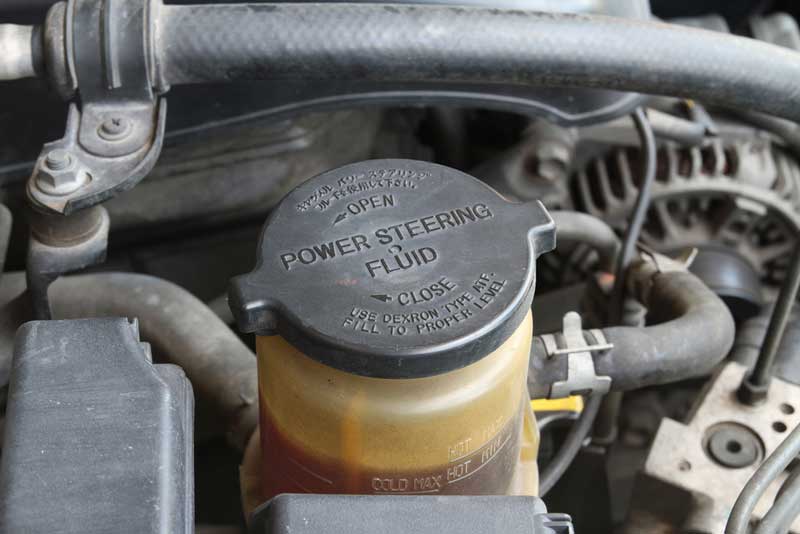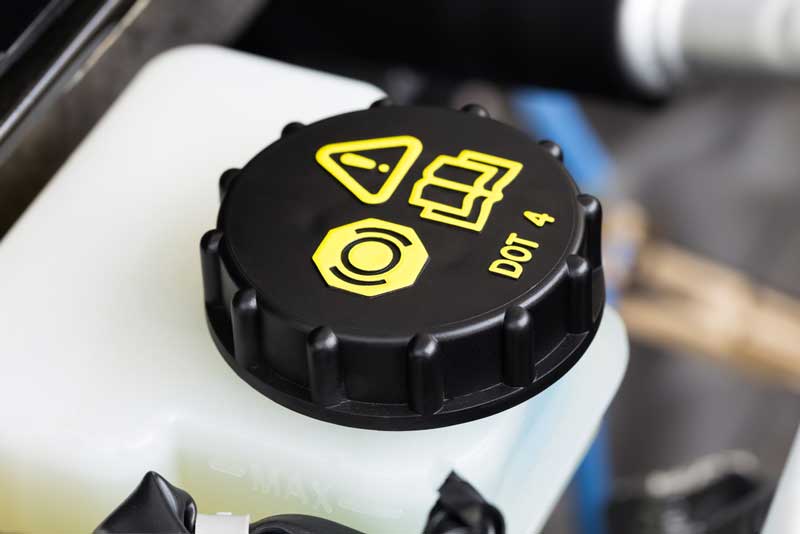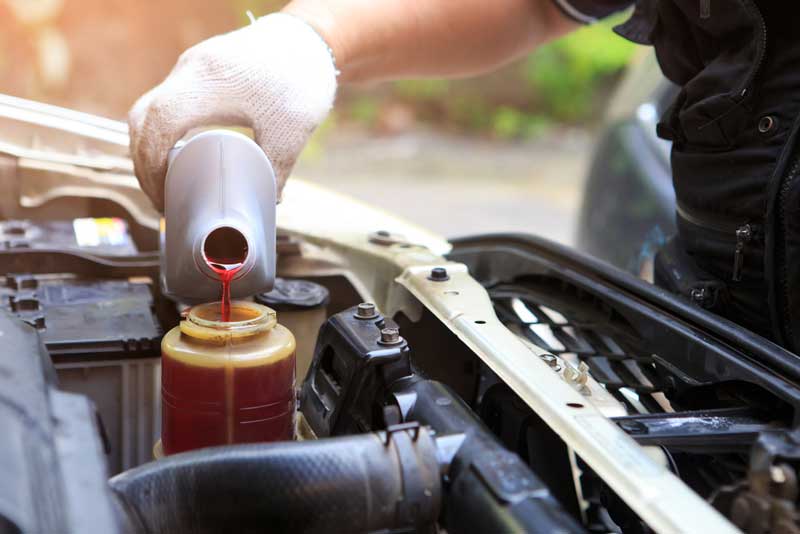Can you use brake fluid for power steering fluid? This is a question that most vehicle owners seek answers to. It is mainly because when they run out of power steering fluid, the brake fluid could be the only thing available.
The brake fluid and power steering fluid share a similarity. Nonetheless, they also have their differences, except otherwise recommended, putting a fluid where it is not supposed to be, can cause a problem.
This article answers all your questions about the steering and brake fluid, including why brake fluid cannot be used for power steering fluid, the cost of fixing car problems that spring up from using brake oil as a substitute for power steering fluid, and other related topics such as alternatives that may be used for power steering fluid.
Let’s begin!
Can You Use Power Steering Fluid as Brake Fluid?
Anticipate a total failure of your brake system if you use your brake fluid in place of your power steering fluid. This also applies to your brake system; you should not even let a little amount of power steering fluid drop into the brake fluid reservoir.
Although the power steering fluid and brake fluid share a similarity, they also have their differences. When you put a fluid where it should not be, eventually, problems will arise. Even if it is a small quantity, issues will eventually arise, and you will not want that.
Sometimes we encounter emergencies, or mistakenly put the brake fluid in the power steering or the other way around.
In this article, you will learn the difference between the fluids, and possible things that may occur when you interchange one with another.
This begs the question, what if you temporarily put power steering fluid inside the brake system or the other way around? Here’s what you can do.

Can Power Steering Fluid Serve for the Brakes?
You are aware that the brake fluid should not be used in the power steering. Can one use the power steering fluid to top the brake fluid? Of course not!
The brake line rubbers are not made to retain petroleum-based fluids, just like the power steering fluid. As a result, the seal immediately starts swelling as it meets with the steering fluid, leading to blocks on one’s brake lines.
A single pump of one’s brake pedal will be sufficient to take a contaminated fluid throughout a whole brake system. As the power steering fluid is introduced into the brake system, it fails quickly.
It can be repaired by dismantling the brake system, cleaning the line, and changing the rubber pieces.
What Is the Power Steering Fluid?
The fluid aims to give room for applying pressure to one’s hydraulic piston, to be able to easily turn the vehicle’s wheels.
Power steering fluid functions as the hydraulic liquid. Rather than affecting the brake, it aids in boosting your steering and lets you turn your steering wheel without stress.
Old cars do not have a power steering pump, and a reasonable quantity of force is needed for one to turn its steering wheel, as the car is stationary.
The ground for a power steering fluid is a synthetic base, mineral oil, or silicone. This means that the power steering fluid has additional similarities with the automatic transmission fluid, which is more than the brake fluid.
Also Read: Transmission Slipping (Causes & Fix)
How to Add Up Power Steering Fluid
First, find your reservoir and check the fluid level. You will have to top it up if it is low.
Afterward, examine the condition. You will notice the condition of your power steering fluid, from its color. It is supposed to be clear, amber, or pink. If your system has an issue, it will become contaminated and turn black or brown.
When you see that, take your vehicle to a professional mechanic. The fluid should be detected, flushed, and replaced, as soon as possible. If it is either a worn O-Ring, a cracked hose, or a seal – it will need to be replaced.
Nonetheless, if everything appears good, just add the proper power steering fluid to your vehicle. Then, while topping it up, make sure to get to the stated mark. As your engine is heating up while driving, it expands, and excessive liquid can cause damage.
People may suggest that you drive without the power steering fluid. Of course, it is possible. Although, it will be tricky to control the vehicle.
You will discover that the pinion, pump, and rack will wear out faster because it has nothing lubricating or protecting it. Ensure you keep to your manufacturer’s suggestions and the right top-up level.
What Is Brake Fluid?
The fluid aims to find a way of helping your brake put pressure on your rotors, to retain the ability to stop.
Brake fluid is a lubricant, and turns force to pressure to increase brake power. Your fluid acts on your hydraulic system because it depends on the liquid’s non-compressible nature.
The manufacture of brake fluid is kept at high standards. We have numerous governing bodies which will show their requirements, such as the Society of Automotive Engineers (SAE standard) and the International Standards Organisation (ISO standard). The very famous standard is produced by Federal Motor Vehicle Safety Standards – DOT standard.
Viscosity plays a paramount role in how effective a brake fluid is. The fluid is to retain the exact viscosity, under extreme cold and high heat to function effectively, mostly in systems using ABS, traction control, and ESP, which can use rapid activation and micro-valves. DOT 5.1, DOT 4+, and DOT 5 are fluids with the lowest viscosity.
The boiling point is important, because brake fluid gets to a high temperature in its system, mostly in parts closest to the brake calipers.
Vaporization is also important because gas can be compressed and can contradict the hydraulic effect. You may have encountered this when an air bubble gets caught up in your brake system.
The brake fluid should be non-corrosive and protect components from corrosion, ABS module, brake lines, wheel cylinders, and calipers.
To attain the effect, corrosion inhibitors and additives are put in the fluid compound. People have tried using silicone oils that are non-corrosive, rather than a mixture of glycol-base. Thus, its incompatibility with the ABS is what has limited the spread.
In summary, the brake fluid is made from three components: anti-corrosive additives, lubricating synthetic materials, and borate ester or glycol ether.

How To Add Up Brake Fluid
You will possibly see a little filter on the way, as you take off your reservoir cap. While examining the condition of your fluid, it is important to remove it temporarily. Then, change it immediately after you have taken a look.
Note: as you work with the brake fluid, bleed your brakes regularly. Air can enter your system, leaving the system in an inefficient state as you begin to drive.
For one to bleed the brakes, find a friend, the bleed bottle, or a piece of automotive equipment, and you’ll need experience too. Do not do this on your own, if you have not done it previously.
As the filter has been put back, pour the right kind of brake fluid inside your reservoir, and keep filling to the right marks. So long as the level does not come lower than “MIN,” as stated above, this is all you require.
Change the cap and carry the vehicle for a gentle and slow drive in the area, to ensure it is working properly. If there is a mistake, you will notice it immediately. Thus, you must simply call a professional mechanic to handle the situation.
Do not drive the vehicle when it is not safe for you.
When fluid is dirty and brown as you examine it, it is high time to flush the system fully. You can do this independently, but it is best taken to a professional mechanic. It is not expensive and will save the stress of making mistakes, and spoiling the system.
Dangers of Using Brake Fluid in Place of Power Steering Fluid
The main difference in chemical composition is why power steering and brake fluids aren’t interchangeable.
Although its effect is restrained through additives, borate ester or glycol ether when used as a brake fluid have a corrosive property, this will make rubber seals wear out when they cannot withstand chemical compound.
The second most serious issue is when there is little or no lubrication. Fluid for power steering has very strong lubricant components, more than that for a brake.
Hence, it will be insufficient to use brake fluid as a replacement, because it will not be a good lubricant, and it will easily wear out your power steering pump.
What Can I Use As A Substitute For Power Steering Fluid?
The main types of fluids that one can use in the vehicle’s power steering system are as follows:
- Power steering fluid
- Automatic transmission fluid (when the manufacturer recommends it)
The automatic transmission fluid has a similar composition to that of your power steering fluid, to the extent that manufacturers suggest you use it for either application.
Vehicles use less power steering fluid than transmission; manufacturers produce various packaging, to advertise the fluid for different prices.
Although, to be aware of whether you are purchasing an original or not, consult your owner’s manual to know the exact fluid you need for your power steering.
Above all, the cost difference isn’t so much. If you purchase oils from the local store, Amazon, or the gas station (they have various power steering oils, engines, brakes, and transmissions), it is best to buy extra and store them in your vehicle’s trunk.
What if I Poured Brake Fluid into Power Steering Reservoir by Chance or Vice Versa?
Pouring brake fluid into the power steering system can cause damage to the power steering pump. Use products that are petroleum based to lubricate the pump, but know that brake fluid is normally alcoholic.
On the other hand, making use of the power steering fluid (a product that is petroleum based), for your brake system, can damage the brake seals. Rubber seals are prone to swelling, because of exposure and lead to braking and leaking problems.
If the brake fluid leaks, paint can be dissolved from surfaces.
Going back to the issue, immediately you notice that brake fluid has been poured in, try to get it out of your reservoir. It is easier to do so when the car is off. When it is on, flushing is recommended.
Take these measures:
- Using a fluid pump or turkey baster, one can remove the brake fluid from the power steering reservoir. An alternative is detaching that return line, from its steering pump found on your primary side.
- Point the line towards an old container or bucket, till your reservoir becomes empty. Many people will crank the tires from one side to the other, as the front part of the vehicle is lifted to eliminate excess fluid, and clean their system. Also, put the new fluff power system to flush the brake fluid, as you return the line and empty it.
- As soon as your system is neat, reconnect your return line. Fill up the reservoir to get to the maximum line with its power steering fluid. Keep your cap on your reservoir, then turn your vehicle for a few seconds, to ensure there isn’t air in your system.
- Re-examine the fluid level of your power steering and then add fluid. Also, examine for leaks in the changed return line. Then turn on your vehicle to know if there is any strange noise, and examine if the fluid level is sufficient and every other thing is good.
Cost of Fixing the Issues Caused by Brake Fluid in the Power Steering
It will depend on the extent of damage caused by the brake fluid; this depends on the quantity of brake fluid poured into the system, and if it went into the whole power steering system.
These are ballpark figures that will serve as an aid. They are estimates and vary depending on the car, location, and mechanic/labor.
When the brake fluid is poured into the power steering, it is necessary to flush the fluid and change it with a new one. If you do not believe in how to DIY, then you will spend about $69.99. The price depends on the amount of fluid that your power steering uses.
Also Read: Transmission Fluid Leak (Causes & Solution)
Frequently Asked Questions – Can You Use Power Steering Fluid as Brake Fluid?
What happens if you put power steering fluid in your brakes?
The major mistake is putting power steering fluid into your brakes. The power steering fluid contaminates the seals, and it starts swelling. As it swells, it moves forward and blocks your passage, causing the brake system not to function well.
What can I substitute brake fluid with?
Soap solution and water are the best substitutes for brake fluid. The reason is that you can easily make it. You can find it in your home, sometimes in the car too.
What can I use if I don’t have brake fluid?
Mix sixty percent of water and forty percent of detergent. Put the solution like usual brake fluid.
What can be used in place of DOT 3 brake fluid?
You must purge your system of the previous DOT3 fluid, to be at an advantage over DOT4 features (high boiling point, wet or dry). The difference is how hot it gets before it boils.
Can you use power steering fluid in place of brake fluid?
The brake and power steering oil are hydraulic fluids. The difference is in the chemical composition. Therefore, you cannot interchange the fluids, because it will damage your master cylinder, power steer pump, and other expensive components.
Conclusion – Can You Use Power Steering Fluid as Brake Fluid?
As you know of the difference between the fluids, if someone asks for an alternative fluid for the power steering, you know better to remind them to keep to the recommendation, but if an alternative comes up, we will state it.
Hence, the question about interchanging the brake fluid with the power steering fluid is a NO. If you need more alternatives, check the manufacturer’s manual and make your choice.

